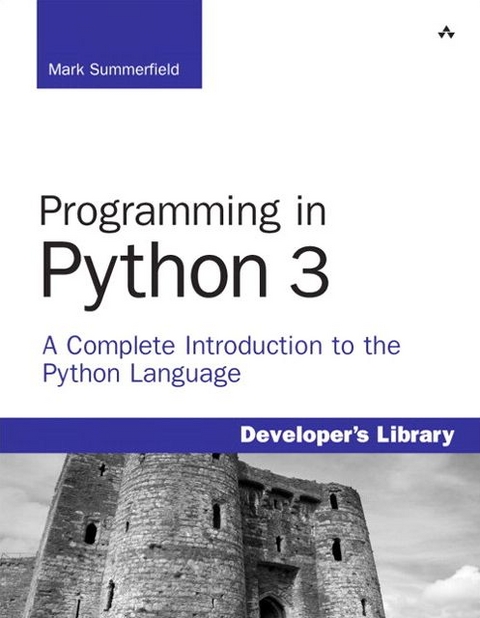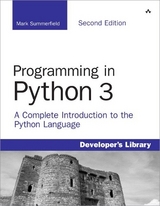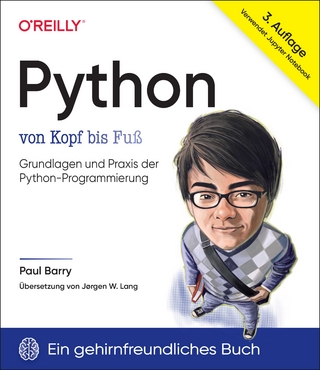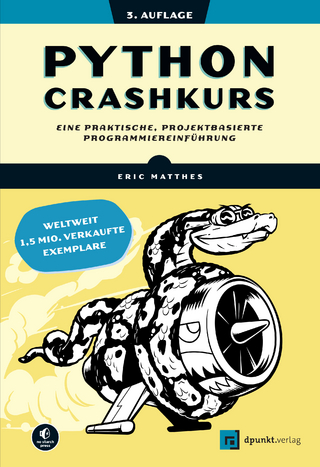
Programming in Python 3
Addison-Wesley Educational Publishers Inc (Verlag)
978-0-13-712929-4 (ISBN)
- Titel erscheint in neuer Auflage
- Artikel merken
Summerfield draws on his many years of Python experience to share deep insights into Python 3 development you won’t find anywhere else. He begins by illuminating Python’s “beautiful heart”: the eight key elements of Python you need to write robust, high-performance programs. Building on these core elements, he introduces new topics designed to strengthen your practical expertise–one concept and hands-on example at a time. This book’s coverage includes
Developing in Python using procedural, object-oriented, and functional programming paradigms
Creating custom packages and modules
Writing and reading binary, text, and XML files, including optional compression, random access, and text and XML parsing
Leveraging advanced data types, collections, control structures, and functions
Spreading program workloads across multiple processes and threads
Programming SQL databases and key-value DBM files
Utilizing Python’s regular expression mini-language and module
Building usable, efficient, GUI-based applications
Advanced programming techniques, including generators, function and class decorators, context managers, descriptors, abstract base classes, metaclasses, and more
Programming in Python 3serves as both tutorial and language reference, and it is accompanied by extensive downloadable example code–all of it tested with the final version of Python 3 on Windows, Linux, and Mac OS X.
Mark Summerfield, owner of Qtrac Ltd., is an independent trainer, consultant, technical editor, and writer specializing in Python, C++, Qt, and PyQt. His books include Rapid GUI Programming with Python and Qt: The Definitive Guide to PyQt Programming (Addison-Wesley, 2008) and, cowritten with Jasmin Blanchette, C++ GUI Programming with Qt 4 (Addison-Wesley, 2006). As Trolltech’s documentation manager, Mark founded and edited Trolltech’s technical journal, Qt Quarterly.
Introduction1
Chapter 1: Rapid Introduction to Procedural Programming7
Creating and Running Python Programs 7
Python’s “Beautiful Heart” 12
Examples 36
Summary 42
Exercises 44
Chapter 2:Data Types47
Identifiers and Keywords 47
Integral Types 50
Floating-Point Types 54
Strings 61
Examples 88
Summary 95
Exercises 97
Chapter 3: Collection Data Types99
Sequence Types 99
Set Types 112
Mapping Types 117
Iterating and Copying Collections 127
Examples 138
Summary 146
Exercises 147
Chapter 4: Control Structures and Functions149
Control Structures 149
Exception Handling 153
Custom Functions 161
Example: make_html_skeleton.py 175
Summary 181
Exercise 182
Chapter 5: Modules185
Modules and Packages 185
Overview of Python’s Standard Library 202
Summary 219
Exercise 220
Chapter 6: Object-Oriented Programming223
The Object-Oriented Approach 224
Custom Classes 228
Custom Collection Classes 251
Summary 272
Exercises 274
Chapter 7: File Handling277
Writing and Reading Binary Data 282
Writing and Parsing Text Files 294
Writing and Parsing XML Files 302
Random Access Binary Files 313
Summary 326
Exercises 327
Chapter 8: Advanced Programming Techniques329
Further Procedural Programming 330
Further Object-Oriented Programming 353
Functional-Style Programming 384
Example: Valid.py 388
Summary 390
Exercises 392
Chapter 9: Processes and Threading395
Delegating Work to Processes 396
Delegating Work to Threads 400
Summary 409
Exercises 410
Chapter 10: Networking413
Creating a TCP Client 414
Creating a TCP Server 420
Summary 427
Exercises 427
Chapter 11: Database Programming431
DBM Databases 432
SQL Databases 436
Summary 443
Exercise 444
Chapter 12: Regular Expressions445
Python’s Regular Expression Language 446
The Regular Expression Module 455
Summary 464
Exercises 465
Chapter 13: Introduction to GUI Programming467
Dialog-Style Programs 470
Main-Window-Style Programs 476
Summary 491
Exercises 491
Epilogue493
Index495
| Erscheint lt. Verlag | 23.12.2008 |
|---|---|
| Verlagsort | New Jersey |
| Sprache | englisch |
| Gewicht | 984 g |
| Themenwelt | Informatik ► Programmiersprachen / -werkzeuge ► Python |
| Mathematik / Informatik ► Informatik ► Web / Internet | |
| ISBN-10 | 0-13-712929-7 / 0137129297 |
| ISBN-13 | 978-0-13-712929-4 / 9780137129294 |
| Zustand | Neuware |
| Informationen gemäß Produktsicherheitsverordnung (GPSR) | |
| Haben Sie eine Frage zum Produkt? |
aus dem Bereich



